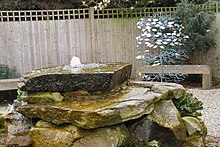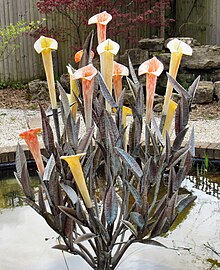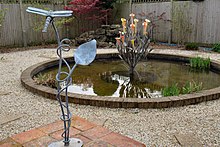Mortlake Crematorium
 From Wikipedia - Reading time: 13 min
From Wikipedia - Reading time: 13 min
| Mortlake Crematorium | |
|---|---|
 | |
 | |
| General information | |
| Type | Crematorium |
| Location | Kew Meadow Path Richmond TW9 4EN England United Kingdom Area: Kew, London Borough of Richmond upon Thames[1] |
| Construction started | 1936 |
| Completed | 1939 |
| Opening | 1939 |
| Cost | £27,000[2] |
| Owner | London boroughs of Ealing, Hammersmith & Fulham, Hounslow and Richmond upon Thames |
| Management | Mortlake Crematorium Board |
| Design and construction | |
| Architect(s) | Douglas Barton[2] |
| Developer | Hammersmith Metropolitan Borough Council |
| Website | |
| www | |
Listed Building – Grade II | |
| Official name | Mortlake Crematorium |
| Designated | 5 May 2011 |
| Reference no. | 1400834 |
Mortlake Crematorium is a crematorium in Kew,[1] near its boundary with Mortlake, in the London Borough of Richmond upon Thames. It opened in 1939, next to Mortlake Cemetery.
The crematorium serves the boroughs of Ealing, Hammersmith & Fulham, Hounslow and Richmond upon Thames in the west and south-west of London. It is managed by a board made up of three elected councillors from each of these four boroughs.[2]
Citing it as "a rare example" of Art Deco design in the borough, Richmond upon Thames Council has described it as "a building of exceptional quality and character".[3] Environmentalist Colin Hines describes it as "probably the most undiscovered deco treasure in London".[4] Hilary Grainger, writing in Encyclopedia of Cremation, describes the architectural style as Italianate and the building as having "beautiful cloisters with discrete brick detailing".[5] It has been a Grade II listed building since 2011, being assessed by Historic England as having "a distinctive Art Deco design that survives little altered in a compact and practical composition".[6]
Location
[edit]The crematorium is on Kew Meadow Path, Townsmead Road,[7] Kew.[1] It is situated on the south bank of the River Thames by Chiswick Bridge and in Clifford Avenue, adjoining Mortlake Cemetery (Hammersmith New Cemetery) in the angle of Mortlake Road (which forms part of the A205, the South Circular Road) and the A316 road. The nearest train stations are Kew Gardens (for London Underground and London Overground trains) and Mortlake (for South Western Railway services).
History
[edit]


Mortlake Crematorium was built on the site of Pink's Farm, which had belonged to Richard Atwood, whose family were prominent market gardeners in the area.[8]
| Mortlake Crematorium Act 1936 | |
|---|---|
| Act of Parliament | |
 | |
| Long title | An Act to constitute a joint board comprising representatives of the Hammersmith Borough Council and the corporations of Acton Barnes and Richmond to authorise the Board to provide and maintain a crematorium and for other purposes. |
| Citation | 26 Geo. 5. & 1 Edw. 8. c. xxi |
| Dates | |
| Royal assent | 31 July 1936 |
It was licensed in 1936 under the Mortlake Crematorium Act 1936, thereby becoming the first to be established under its own act of Parliament.[2] Designed by Douglas Barton,[6] borough surveyor to Hammersmith Metropolitan Borough Council,[6] the building was constructed in three years at a cost of £27,000.[2] It was also equipped with a Garden of Remembrance for the burial or scattering of ashes, and also offered panels and niches in which ashes could be deposited. When the facility was finally opened in January 1939 by Lord Horder, the then Physician to the King, he said: "You seem to have eliminated the sombreness of atmosphere which sometimes shrouds buildings such as these".[2][4] After that, there was very little change in Mortlake Crematorium's outward appearance until 1982, when Colin Gilbert, an architect from Ealing, designed additional gardens between the crematorium and the River Thames.[2] Since 2015 the crematorium has had a memorial garden dedicated to the memory of babies and children, based on Doris Stickley's story "Water Bugs and Dragonflies".[9][10]
Three new, larger cremators were installed in the crematory in 2012.[11]
Notable cremations
[edit]Among those cremated here were:
- Trevor Baylis (1937–2018), inventor, whose body was cremated in a novelty coffin fashioned as the wind-up radio that he had invented[12]
- Richard Beckinsale (1947–1979), actor[13]
- Frederick Bentham (1911–2001), theatre lighting designer and engineer[14]
- Tarka Cordell (1966–2008), musician[15]
- Tommy Cooper (1921–1984), comedian and magician[16]
- Sir Robin Day (1923–2000), political broadcaster and commentator[16]
- Roger Delgado (1918–1973), actor, most famous for playing The Master in Doctor Who[17]
- Sheila Dunn (1940–2004), stage and television actress[18]
- Kenny Everett (1944–1995), radio DJ and television entertainer[19]
- Edd Gould (1988–2012), animator, voice actor and creator of Eddsworld[20]
- Charles Hawtrey (1914–1988), comedy actor[21]
- Valerie Hobson (1917–1998), actress[22]
- John Hutchinson (1884–1972), botanist, taxonomist and author[23]
- Arthur Koestler (1905–1983), author[24]
- James Edgar Leach (1892–1958), Victoria Cross recipient, World War I[25]
- Charles Lightoller (1874–1952), second officer of the RMS Titanic[26]
- Lord Longford (Frank Pakenham) (1905–2001), politician and social reformer[27]
- Ernestine Mills (1871–1959), artist, writer and suffragette[28]
- Kirsty MacColl (1959–2000), singer-songwriter[29]
- Jimmy Perry (1923–2016), actor and scriptwriter, who devised and co-wrote the BBC television sitcom Dad's Army[30]
- Christopher Price (1967–2002), radio and television broadcaster[31]
- John Profumo (1915–2006), politician, Secretary of State for War[32]
- Sir Michael Redgrave (1908–1985), actor, author and director[16]
- Gordon Reid (1939–2003), Scottish actor[33]
- Prince Alexander Romanov (1929–2002), member of the Russian Imperial Family[27]
- Dame Maggie Smith (1934–2024), actress[34]
- Sir Denis Thatcher, Bt (1915–2003), businessman and husband of Margaret Thatcher[35]
- Margaret Thatcher, Baroness Thatcher (1925–2013), Prime Minister of the United Kingdom[35][36][37][38][39]
- Alexander Trocchi (1925–1984), Scottish novelist[40]
- Stephen Ward (1912–1963), osteopath and artist who was one of the central figures in the Profumo affair[41]
- Kit West (1936–2016), special effects artist, known for his work on Raiders of the Lost Ark and Return of the Jedi[42]
World War II memorial
[edit]Seventy-nine Commonwealth service personnel of World War II were cremated here and their names are listed on a screen wall memorial erected by the Commonwealth War Graves Commission in the adjoining Mortlake Cemetery (Hammersmith New Cemetery).[43] They include England rugby international Vivian Davies (1899–1941), who was a Captain in the Royal Artillery.[44]
References
[edit]- ^ a b c "Village Plan for the Kew area". London Borough of Richmond upon Thames. 12 July 2017. Retrieved 2 September 2017.
- ^ a b c d e f g "History and the Board". Mortlake Crematorium. Retrieved 27 April 2023.
- ^ "Cabinet Member for Environment and Planning. Report of: Assistant Director Environment Planning & Review. Subject: Buildings of Townscape Merit". London Borough of Richmond upon Thames. 9 February 2004. Retrieved 6 January 2017.
- ^ a b Colin Hines (2003). Art Deco London. Twickenham, London: Park House Press. p. 56. ISBN 0-9544751-0-0.
- ^ Hilary Grainger (2005). "Cloisters" in Lewis H Mates; Douglas J Davies (editors). Encyclopedia of Cremation. Ashgate Publishing. ISBN 978-0-7546-3773-8.
- ^ a b c Historic England (5 May 2011). "Mortlake Crematorium (1400834)". National Heritage List for England. Retrieved 8 March 2023.
- ^ "Contact". Mortlake Crematorium. Retrieved 22 September 2024.
- ^ David Blomfield (1994). Kew Past. Phillimore & Co Ltd. pp. 76–77. ISBN 0-85033-923-5.
- ^ "West London Sands Receives Sizeable Donation From Mortlake Crematorium". ChiswickW4.com. 22 June 2016. Retrieved 2 September 2017.
- ^ Doris Stickley. "Water Bugs and Dragonfiles". BelovedHearts.com. Retrieved 3 September 2017.
- ^ Jonathan Owen; Tabby Kinder (11 March 2012). "A nail in the coffin of old funeral ways". The Independent on Sunday. Retrieved 24 July 2017.
- ^ Lawrence Smith-Higgins (2 May 2018). "Trevor Graham Baylis CBE (13 May 1937 – 5 March 2018)". Intellectual Property Office Blog. Retrieved 30 November 2023.
- ^ David Clayton (2008). The Richard Beckinsale Story. Stroud: History Press. p. 173. ISBN 978-0-7509-5061-9.
- ^ "Fred Bentham: Funeral Details". Light and Sound International. 17 May 2001. Archived from the original on 23 August 2021. Retrieved 23 August 2021.
- ^ "Tarka Cordell's funeral". The Daily Telegraph. 9 May 2008. Retrieved 6 September 2015.
- ^ a b c Amy Dyduch (26 March 2004). "Mortlake Crematorium marks 75 years". Richmond and Twickenham Times. Retrieved 22 September 2024.
- ^ Marcus K Harmes (2017). Roger Delgado: I am usually referred to as The Master: a biography. London: Fantom Publishing. p. 213. ISBN 978-1-78196-300-5.
- ^ "Obituary: actress Sheila Camfield". Richmond and Twickenham Times. 26 March 2004. Retrieved 22 September 2024.
- ^ "Transitions". The Advocate (681). Here Media: 19. 16 May 1995. ISSN 0001-8996.
- ^ Steve Dawson (2 January 2017). "What Happened to Edd Gould of Eddsworld? – A 2018 Update". Gazette Review. Retrieved 2 December 2023.
- ^ Roger Lewis (2002). Charles Hawtrey 1914–1988: The Man Who Was Private Widdle. London: Faber and Faber. ISBN 978-0571210893.
- ^ Scott Wilson (2016). Resting Places: The Burial Sites of More Than 14,000 Famous Persons. McFarland & Company. p. 344. ISBN 978-0-7864-7992-4.
- ^ C E Hubbard (November 1975). "John Hutchinson. 7 April 1884 – 2 September 1972". Biographical Memoirs of Fellows of the Royal Society. 21: 345–365. doi:10.1098/rsbm.1975.0009. JSTOR 769686. S2CID 85985378.
- ^ David Cesarani (1998). Arthur Koestler: The Homeless Mind. William Heinemann Ltd. ISBN 978-0434113057.
- ^ Iain Stewart. "Grave location for holders of the Victoria Cross in Surrey". www.victoriacross.org.uk. Retrieved 6 September 2015.
- ^ "Titanic Passengers and Crew Buried in Mortlake Crematorium Richmond". Encyclopedia Titanica. Retrieved 22 September 2024.
- ^ a b "Mortlake Crematorium" (PDF). On Kew. Kew Society. Spring 2006. Archived from the original (PDF) on 12 December 2013. Retrieved 24 July 2017.
- ^ "Humanist Heritage: Ernestine Mills (1871-1959)". Humanist Heritage. Retrieved 4 December 2021.
- ^ Jean MacColl (2009). Sun on the Water – The Brilliant Life and Tragic Death of my Daughter Kirsty. John Blake Publishing. p. 344. ISBN 978-1-61185-976-8. Retrieved 6 January 2018.
- ^ Mark Braxton (7 November 2016). "Friends, family and famous fans bid farewell to Dad's Army creator 'Gentleman Jim' Perry". Radio Times. Retrieved 2 December 2023.
- ^ "Poignant farewell to Price". BBC News. 8 May 2002. Retrieved 22 September 2022.
- ^ John Lawton (1992). Unholy Joy: 50 Years On – A Short History of the Profumo Affair. Hodder & Stoughton. ISBN 978-1-61185-976-8.
- ^ Calum McDonald; Karen Bale (4 December 2003). "Top Scots actor dies on stage: Gordon has heart attack". Daily Record (Scotland), republished by The Free Library. Retrieved 22 September 2024.
- ^ Dame Maggie Smith laid to rest in 'beautiful goodbye' at intimate funeral
- ^ a b Gordon Rayner & Andrew Hough (17 April 2013). "Baroness Thatcher: Tearful Sir Mark and Carol Thatcher say final farewell to their mother at cremation". The Daily Telegraph. Retrieved 12 February 2017.
- ^ Amy Dyduch (17 April 2013). "Margaret Thatcher supporters line streets of Mortlake". Richmond and Twickenham Times. London. Retrieved 22 September 2024.
- ^ Andrew Sparrow; Paul Owen (17 April 2013). "Margaret Thatcher's funeral – Tuesday 16 April". The Guardian. Retrieved 2 February 2018.
- ^ "Baroness Thatcher's funeral: Procession details". ITV. 17 April 2013. Retrieved 12 July 2022.
- ^ Prime Minister's Office, 10 Downing Street (16 April 2013). "Lady Thatcher's funeral – timings". gov.uk. Retrieved 12 February 2017.
{{cite web}}: CS1 maint: numeric names: authors list (link) - ^ Andrew Murray Scott (2012). Alexander Trocchi: The Making of the Monster (Second, revised and expanded ed.). Edinburgh: Polygon. p. 220. ISBN 978-1-84921-072-0.
- ^ "Cremation Writes Finis To Dr. Ward's Sordid Career After Suicide Verdict". St. Petersburg Times. St. Petersburg, Florida. 9 August 1963. pp. 3–A. Retrieved 21 February 2017.
- ^ Ben Weich (30 April 2016). "Oscar-winning special effects guru and East Sheen native Kit West dies aged 80". Richmond and Twickenham Times. Retrieved 11 June 2016.
- ^ "Mortlake Crematorium". Commonwealth War Graves Commission. Retrieved 2 December 2023.
- ^ "Captain Vivian Gordon Davies". Casualty details. Commonwealth War Graves Commission. Retrieved 12 July 2022.
 KSF
KSF

